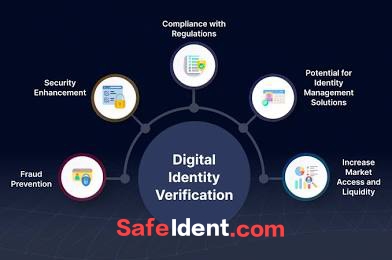IT IS YOUR MONEY
Digital Identity and Asset Ownership Security
Digital identity is the cornerstone of secure asset ownership in the blockchain era, enabling verified, self-sovereign control over digital and tokenized assets. By linking identity to wallets via decentralized identifiers (DIDs), users can prove ownership, comply with regulations, and prevent fraud. Projects like SafeIdent (safeident.com) Customer Verification Service Using SafeDataShare (SDS) Technology are advancing this critical infrastructure unlocking trust in the digital finance ecosystem

Decentralized Identifiers (DIDs) allow individuals to own their identity without relying on centralized authorities. These identifiers are stored in digital wallets and can be selectively shared—e.g., proving accreditation to invest in a security token without revealing full personal data.
This model, known as self-sovereign identity (SSI), ensures privacy, security, and compliance in digital asset transactions.
How It Enhances Asset Ownership and Compliance
When purchasing a tokenized property or private equity share, investors must undergo KYC (Know Your Customer) checks. Instead of submitting documents repeatedly to each platform, a verified digital identity can be reused across ecosystems.
For example, a user verified by a trusted institution (e.g., a bank or government) receives a verifiable credential (VC) stored in their wallet. When accessing a tokenized real estate platform, they present this VC—proving eligibility without exposing sensitive data.
Smart contracts can automatically enforce rules based on identity attributes—e.g., restricting token transfers to accredited investors only.
This reduces friction, enhances security, and supports regulatory compliance without sacrificing user control.
Real-World Implementations and Global Initiatives
The European Union’s EUDI Wallet allows citizens to store digital IDs, diplomas, and driving licenses, with plans to integrate financial credentials. By 2025, it will support cross-border access to regulated digital asset platforms.
Microsoft’s ION, built on Bitcoin, enables scalable DIDs for millions of users. It’s used by enterprises and governments to issue secure digital credentials.
In Switzerland, the SwissPass initiative combines national ID with blockchain-based access to public and financial services. Similarly, Estonia’s e-Residency program allows global entrepreneurs to manage digital assets securely under EU jurisdiction.
Challenges and the Path to Adoption
Interoperability between identity systems remains a hurdle. Standards like W3C’s DID and Verifiable Credentials are critical for cross-platform recognition.
User experience must also improve—managing private keys and digital wallets can be daunting for non-technical users. Custodial solutions with institutional-grade security are emerging to bridge this gap.
As digital assets become mainstream, secure identity is not optional—it’s foundational.
The fusion of identity and ownership is creating a more trustworthy, efficient, and inclusive financial ecosystem. It empowers individuals to control their data while enabling seamless participation in the digital economy.
To learn how secure digital identity can protect your asset ownership and streamline compliance, visit DigitalAssets.Foundation and from specialists get a FREE consultation.

More News
© 2025
